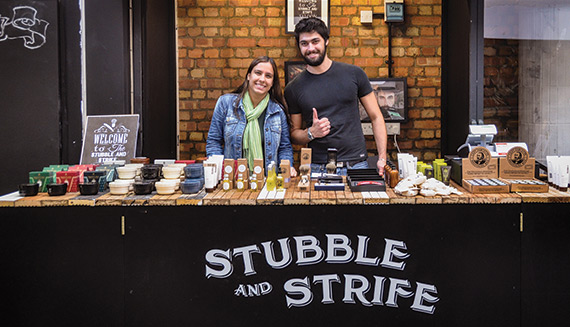
Vast open-plan communal work stations fashioned out of railway sleepers. Marker pens strewn across the bathroom sink, ready for anyone who wishes to indulge a burning desire to doodle on the mirror. Walls, doors, light boxes and windows emblazoned with slogans including “No bullshit”, “The smoking room” and “Space for ideas”. So far, so start-up.
Welcome to Appear Here, the pop-up retail venture founded and run by 23-year-old entrepreneur Ross Bailey. Despite first impressions, it is not one in a long line of innovative young companies that the real estate old guard is finally conceding they might do well to keep half an eye on.
Because there is nothing half-hearted about the way the UK property sector is looking on as the fledging company tears through the industry with a 500% year-on-year growth rate. And in Transport for London’s case, looking on was not enough. Bailey’s pop-up concept was the perfect weapon with which to tackle the Achilles heel of London’s tube stations – dank, dark, crumbling retail units.
Twelve months on the pair is working together as part of a strategy, which kicked off with an entire revamp of Old Street Station, EC1 last year to transform TfL’s transport hubs by delivering an entirely new kind of retail offering. One that will catch the eyes, and imaginations, of the 1.3bn people who pass through them every year. “A year ago the most exciting retail offering you might find in a tube station was a key cutters,” says Bailey. “Can you imagine telling someone back then, just 12 months ago, that brands like FCUK, Moleskine and Jamie Oliver would be fighting to take over the spaces in these transport hubs? Spaces that have been disregarded for years as being dead? They would have laughed in your face.”
But all three of those brands, and vast swathes of others, have been doing just that – fighting to get into one of the new, improved tube stations around the capital. But how does this buzz actually translate into financial gains for TfL as the client? And what does it mean for occupiers in the areas around the stations getting the Appear Here treatment?
Retail revamp

Appear Here’s overarching concept is simple: an online site that links up landlords sitting on empty units with retailers looking for pop-up space. It has seen 10,000 brands and 750 property companies sign up in just two years. The roster includes global superbrands Marc Jacobs, Coca-Cola, Net-a-Porter, Google, Bentley, Adidas, Jamie Oliver and Dove as well as well-known landlords British Land, Land Securities, Hammerson, Capital & Counties and Soho Estates.
The company has delivered some of its property clients 100% returns and 90% occupancy on their space over the past 12 months, proving the power, and profits, of pop-up. And it has been no different for transport. In 2014 Bailey partnered with the body to revamp Old Street tube station. Within just four weeks 15 spaces had been made available and Bailey had closed deals with major brands including Moleskine, Tate Modern and electric bike shop Fully Charged. By May the station was unrecognisable. And now? Now the extent of the financial benefits are starting to become clear. “Old Street station is now producing roughly twice as much rental income thanks to the revamp and the introduction of pop-ups,” says Stuart Anderson, head of retail at TfL.
And with a careful curation process ensuring that the shops and brands in each tube station complement the surrounding area and the types of people who will be passing through (think trendy and creative for Old Street, luxury and polished for South Kensington, for example) the positive impact is showing signs of reaching occupiers nearby. “A well-known Old Street occupier always used to suggest his clients and visitors get a taxi to the office to make sure they didn’t have to go via the tube station. Now he actively tells them to get the tube just so they get to see the new, improved station,” says Anderson.
The power of pop-up
Bailey says that the success so far of pop-up retail in stations comes down to the fact that it works equally well for the commuters and the brands. “You have access to a huge audience automatically, which is an advertiser’s dream,” he says. “Then you are giving commuters something cool, new and different. And it doesn’t have to be traditional retail. It can be an opportunity to showcase what you do and it acts as a live advert. An opportunity to catch people’s attention, so they can see what the brand is all about and then buy online later.
“What we have done at Old Street, Canary Wharf, South Kensington and Piccadilly shows the power of pop-up. Looking back a year ago again, most people would have said that signing 10 shops or brands up to a tube station with a load of five or 10-year leases would be the right thing to do. The safest and the way to get the best returns. Looking at the performance of the stations where pop-up has been introduced, they would be kicking themselves now.”
What’s next?
And the power of pop-up doesn’t look to be waning any time soon. Appear Here has just signed brands including the Cambridge Satchel Company and Burger Bear at Old Street – where it will be working with TfL for the next three years – and Evian at Piccadilly Circus. And this is just the tip of the iceberg. So what’s next?
“We are now using pop-up at other stations,” says TfL’s Anderson. “We are kicking off a year-long trial with Estée Lauder and Aveda at Piccadilly Circus, we are looking at Canary Wharf, Embankment, and St Paul’s. We want people who pass through the stations to be surprised and delighted and we see rolling out the pop-up concept as a great way of achieving that.”
And Bailey – who is looking to take the Appear Here concept overseas, with Paris first on the list – could not agree more. He says: “We took on the Old Street project to prove it could be done. Everything points to the fact that is works.”
The brands making it big
 Stubble and Strife
Stubble and Strife
Find them at: Old Street station
Shaving products firm Stubble and Strife wanted to publicise its Great Shave Saloon. After two months in Old Street Station, it noticed an increase in sales online and offline. Website visits rose 535%.
www.appearhere.co.uk/inspire/success-stories/stubble-strife
Crosstown Doughnuts
Find them at: Piccadilly Circus
The gourmet doughnut takeaway says: “Our product is suited to the ‘grab and go’ customer. Piccadilly Circus is one of the busiest tube stations in London, so couldn’t have suited us better.”
www.appearhere.co.uk/inspire/blog/from-stall-to-store-crosstown-doughnuts
Juiceman
Find them at: Leicester Square station
After Juiceman found it was selling out daily in Old Street station, it went to Leicester Square station to sell its 100% organic juices, smoothies and cleanses. Juiceman was set up by Andrew Potts Dawson, who starred in the Diet Coke ads.
www.justopenedlondon.com/juiceman-leicester-square
Crosstown Doughnuts
Find them at: Piccadilly Circus
The gourmet doughnut takeaway says: “Our product is suited to the ‘grab and go’ customer. Piccadilly Circus is one of the busiest tube stations in London, so couldn’t have suited us better.”
www.appearhere.co.uk/inspire/blog/from-stall-to-store-crosstown-doughnuts
Pop-ups – a problem-free solution to your empty shop?
The landlord that is struggling to find a long-term occupier for an empty shop may well like the sound of a pop-up retailer to occupy in the short term. Flexible, fun, entrepreneurial, minimum fuss, the pop-up shop promises a lot. Is it as attractive as it sounds? Hogan Lovells partner Daniel Norris addresses a few common pitfalls:
Covenant risk and rent
Pop-up occupiers are invariably weak covenants with neither a trading record nor business experience. The landlord takes a risk on whether the occupier will pay its rent or perform its covenants knowing that it is unlikely to be worth suing for any breaches. One solution could be to receive the occupier’s total rent up front or at least in instalments in advance. Although a deposit would provide rental security, the landlord is unlikely to receive this as the occupier will be too concerned about its return even if it could afford it. An alternative turnover rent is impractical as verifying the turnover data may be impossible.
Flexibility
Flexibility for occupiers comprises a flexible right to terminate with no conditions and a refund of any rent paid in advance for the period after the date of termination.
For landlords, the Landlord and Tenant Act 1954 grants rights of security of tenure to a person occupying premises for the purposes of its business for more than six months, or where successive tenancies last more than a year in aggregate. The protected tenant is entitled to renew its lease at the end of its period of occupation, and the law sets significant and expensive hurdles in the way of a landlord that wants to refuse.
To avoid these rights, landlords should exclude the 1954 Act. Watch out, though – if the tenant stays in occupation after the end of the excluded term, it could start accruing 1954 Act rights if it has been there long enough. The landlord should make sure the occupier leaves on expiry or signs up to another excluded tenancy.
Although licences to occupy and tenancies at will are not caught by the 1954 Act, the courts will look at the substantive nature of the deal and if the occupier is granted an exclusive right to occupy (for example, a lockable shop) and pays a rent, it is probably a tenancy and caught by the 1954 Act.
Condition of the property
Although the occupier usually requires minimal alterations to the unit, the landlord will eventually want the property back in no significantly worse state than when the occupier went in. A photo/film record of the condition of the property on day one is a good idea to set a benchmark. Despite this, the occupier will not accept responsibility for the structure of the unit nor pay a service charge and the landlord will need to retain that risk.
Rates
Who is to pay? The parties should be crystal clear on this and ideally the rent will include an element covering business rates.











